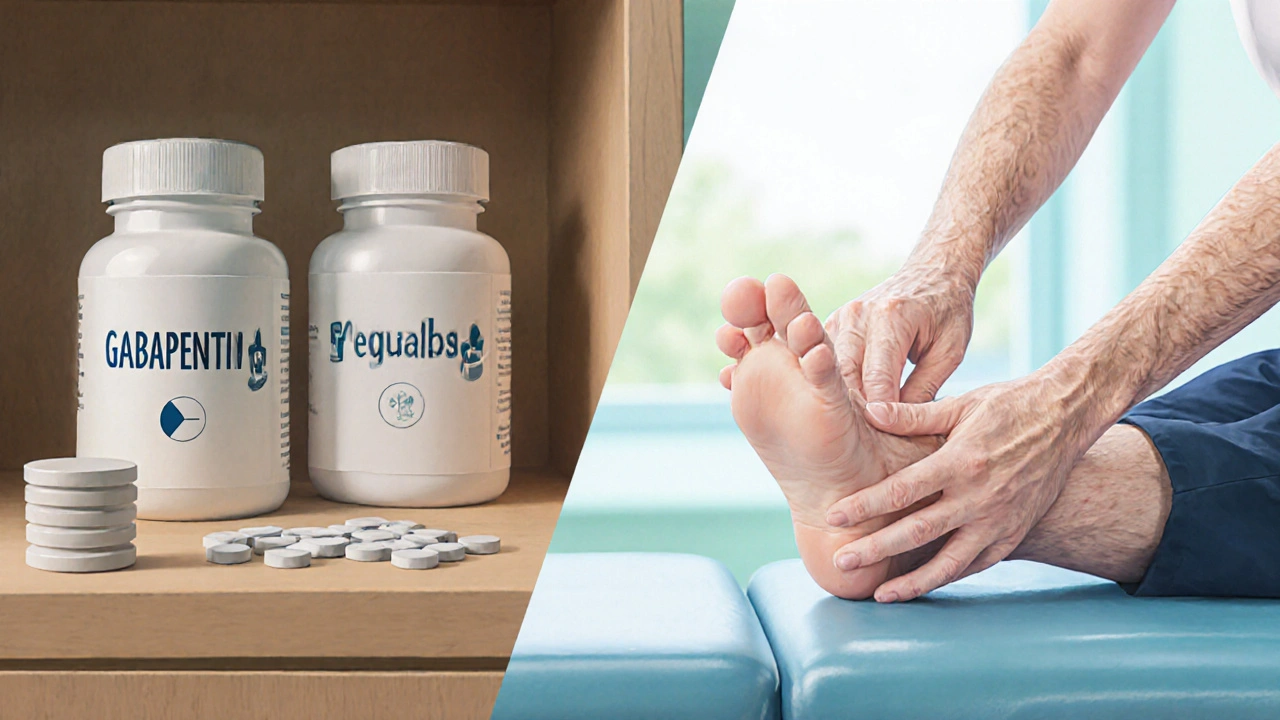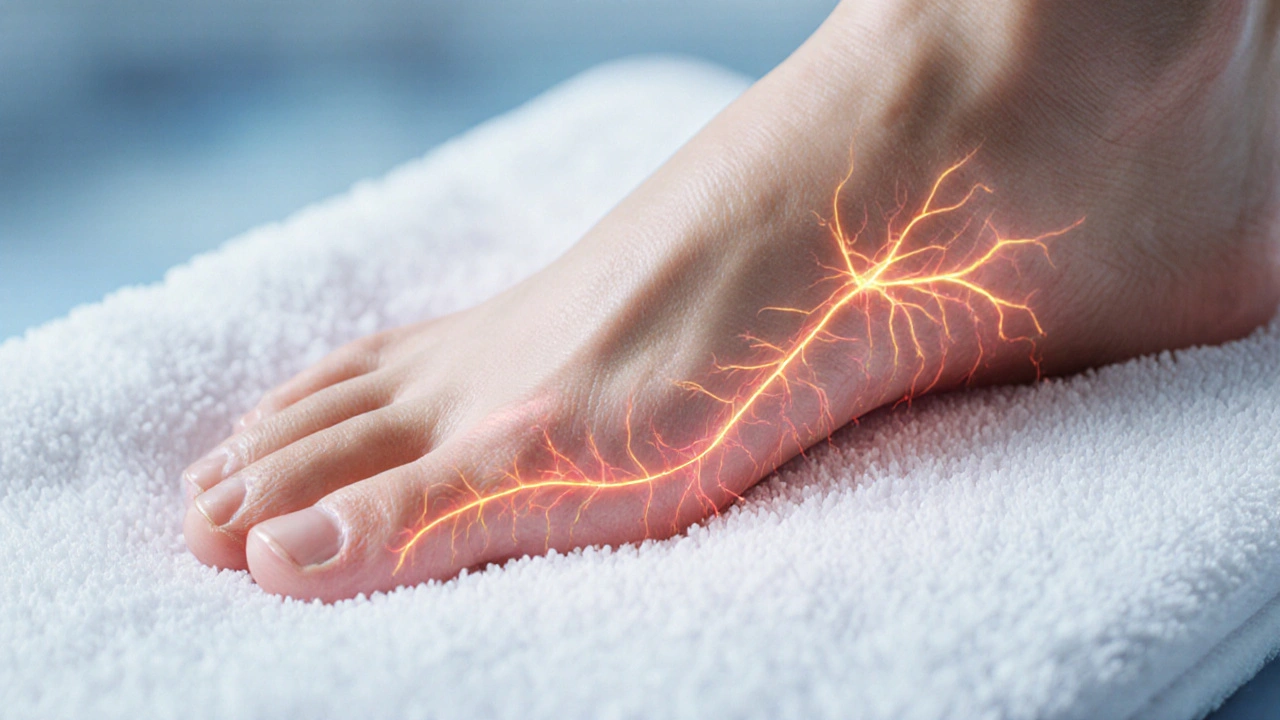Blood Sugar & Pain Tracker
Track Your Daily Levels
Your Insights
Log your first entry to see how blood sugar and pain correlate.
Correlation Chart
Living with Diabetic Peripheral Neuropathy is a nerve‑damage condition caused by high blood sugar that often brings burning, tingling, or stabbing foot pain can feel nonstop. This guide shows you how to tame that pain with everyday habits, smart meds, and simple therapies-so you can get back to walking, working, and enjoying life.
What Exactly Triggers the Pain?
High glucose levels damage the tiny nerves in your feet and hands. Over time, the nerves misfire, sending pain signals even when there’s no injury. Poor circulation, inflammation, and high‑blood‑pressure spikes make the problem worse. Knowing these triggers helps you target them directly.
Keep Blood Sugar in Check
Nothing beats tight glucose control for reducing nerve pain.
- Aim for an HbA1c below 7% (or the target your doctor set).
- Use continuous glucose monitors (CGM) to spot spikes early.
- Follow a balanced diet rich in fiber, low‑glycemic carbs, and healthy fats.
- Exercise at least 150 minutes a week; even a brisk walk improves insulin sensitivity.
When you keep sugar steady, the nerve‑damage process slows down, and pain often eases.
Medication Options - What Works Best?
Prescription drugs are a common first line, but they aren’t one‑size‑fits‑all. Below is a side‑by‑side look at the most used meds.
| Option | Typical Dose | Onset of Relief | Common Side Effects | Notes |
|---|---|---|---|---|
| Gabapentin an anticonvulsant that calms nerve signals | 300-900mg three times daily | 1-2 weeks | Drowsiness, swelling, dizziness | Start low, increase gradually; check kidney function. |
| Pregabalin similar to gabapentin but more potent | 150-300mg twice daily | Within days | Weight gain, blurred vision, edema | Effective for intense burning pain; watch for dependence. |
| Physical therapy | 2-3 sessions/week | Variable | None | Improves strength, balance, and blood flow. |
| Acupuncture | Weekly for 6-8 weeks | Immediate to a few weeks | Minor bruising | Works for many who dislike meds. |
Talk to your healthcare provider about starting meds; they’ll consider kidney health, other prescriptions, and your personal pain level.

Physical Therapy and Exercise
Moving the affected limbs may sound counter‑intuitive when they hurt, but gentle activity boosts circulation and releases endorphins.
- Physical therapy guided exercises that improve gait, strength, and flexibility - focus on ankle pumps, toe curls, and seated leg lifts.
- Exercise regular aerobic activity that enhances glucose uptake - try swimming or cycling to avoid foot impact.
Aim for 10-15 minutes of stretching each morning; it reduces stiffness and the “pins‑and‑needles” feeling.
Home Remedies You Can Try Tonight
- Cold‑/warm‑pack rotation: 15 minutes of a cool pack followed by a warm compress eases nerve firing.
- Topical capsaicin cream: 0.075% to 0.1% concentration can desensitize pain receptors after a few days of use.
- Alpha‑lipoic acid supplement (600mg daily): Some studies show it improves nerve conduction and reduces pain.
- Mind‑body techniques-deep breathing, guided meditation, or progressive muscle relaxation lower overall pain perception.
Foot Care - A Must‑Do Routine
Since the feet are the most common site, daily inspection is critical.
- Check for cuts, blisters, or redness every morning.
- Keep nails trimmed straight across to avoid ingrown nails.
- Wear breathable, properly fitting shoes; avoid high heels or tight slippers.
- Moisturize soles but not between toes to prevent fungal growth.
Consider a certified diabetic shoe fitting once a year; the right shoe can cut pain by up to 40%.

When to Call Your Healthcare Team
If you notice any of these red flags, seek help promptly:
- Sudden increase in pain intensity or new burning sensations.
- Open wounds that don’t heal within a week.
- Changes in skin color (blue, pale, or very red).
- Loss of sensation that leads to balance problems.
Early intervention can prevent ulcers, infections, or even amputation.
Putting It All Together - Your Personal Pain‑Management Checklist
- Log daily blood‑sugar trends; adjust diet or meds as needed.
- Pick a medication (gabapentin or pregabalin) and set a reminder for dosing.
- Schedule a physical‑therapy assessment within the next two weeks.
- Start a 10‑minute foot‑stretch routine each morning.
- Apply a cold‑warm pack rotation at night for 15 minutes.
- Do a quick foot inspection before bed; treat any sore spots.
- Add a weekly mind‑body session (meditation or yoga) to lower stress.
Review this checklist every month and tweak based on what eases your pain the most.
Key Takeaways
- Stable blood sugar is the foundation of nerve‑pain control.
- Gabapentin and pregabalin are first‑line meds; start low and monitor side effects.
- Physical therapy, regular exercise, and proper foot care cut pain dramatically.
- Home remedies like capsaicin cream and cold‑warm packs provide fast relief.
- Seek professional care if pain spikes, wounds appear, or sensation drops.
Frequently Asked Questions
Can I treat diabetic neuropathy pain without prescription drugs?
Yes. Lifestyle changes, physical therapy, acupuncture, topical agents, and supplements like alpha‑lipoic acid can all reduce pain. Many people combine these with low‑dose meds for the best outcome.
How long does it take for gabapentin to start working?
Most patients notice a modest improvement after 1-2 weeks, but full effect may take up to a month as the dose is titrated.
Is it safe to exercise if my feet hurt?
Gentle, low‑impact activities are safe and actually helpful. Start with swimming, stationary cycling, or seated leg raises, and always wear supportive shoes.
What should I do if my pain suddenly worsens overnight?
Check your blood‑sugar level first. If it’s high, correct it and monitor. If pain stays severe or you see a wound, call your doctor or visit urgent care.
Do supplements interfere with diabetes medications?
Some, like high‑dose vitaminE or garlic, can affect blood‑thinning. Always discuss any new supplement with your doctor, especially if you’re on insulin or sulfonylureas.


Comments (10)
Benjie Gillam
14 Oct, 2025When you stare at the micro‑scale chaos of hyperglycemia, you realize that diabetic peripheral neuropathy is not just a symptom but a manifestation of systemic entropy. The relentless glycemic variability fuels oxidative stress, which in turn corrupts the sodium‑potassium pumps on the axonal membranes, leading to aberrant afferent firing. If you map the pain spikes to the post‑prandial glucose surges, a pattern emerges that looks like a fractal of suffering. The key is to break that fractal loop by stabilizing the glucose flux, which can be achieved with continuous glucose monitors (CGM) and a low‑glycemic diet. Moreover, the neuro‑inflammatory cascade can be dampened by omega-3 fatty acids and alpha‑lipoic acid, both of which act as radical scavengers. Pharmacologically, gabapentin modulates the voltage‑gated calcium channels, reducing ectopic discharges, while pregabalin offers a higher binding affinity and faster onset. Yet, you must titrate these agents cautiously because renal clearance can be compromised in long‑standing diabetes. Physical therapy serves as a non‑pharmacologic conduit, enhancing microcirculation through rhythmic muscle contractions, which facilitate glucose uptake via GLUT‑4 translocation. Acupuncture, though controversial, may trigger endogenous opioid release, adding another layer of analgesia. Topical capsaicin, by desensitizing TRPV1 receptors, provides a peripheral counter‑balance to central sensitization. The holistic checklist you follow should integrate these modalities into a coherent algorithm, rather than a haphazard list of hacks. Remember, the pain is a warning signal, not a curse; it tells you that metabolic homeostasis is off‑kilter. By logging blood sugar alongside pain levels, you create a feedback loop that can be optimized with simple statistical tools. The correlation coefficient you observe, whether strong or weak, is a quantitative reflection of that loop. If the coefficient exceeds 0.6, you have empirical evidence that tighter glycemic control will likely attenuate your neuropathic pain. Conversely, a weak correlation suggests additional etiologies, such as micronutrient deficiencies or peripheral vascular disease. Finally, never underestimate the psychosocial component-stress, anxiety, and poor sleep amplify the central sensitization, creating a vicious cycle. Addressing these with meditation or cognitive‑behavioral strategies can reduce the overall pain burden dramatically. In sum, treat diabetic neuropathy pain as a multidimensional problem, and you’ll find that each piece of the puzzle reinforces the others, leading to sustainable relief.
Naresh Sehgal
21 Oct, 2025Stop dithering, get a CGM today and quit guessing your sugar levels!
Poppy Johnston
27 Oct, 2025Thanks for the thorough guide! I’ve been juggling my meds and foot care, and the checklist really helped me prioritize what to do first. I started a simple 10‑minute foot stretch each morning and already feel less tingling. The cold‑warm pack routine at night is surprisingly soothing, and I’ve logged my glucose‑pain data for the past week-turns out my spikes line up with the worst pain episodes. I’ll keep tweaking my diet and maybe add that alpha‑lipoic acid supplement you mentioned. Keep the tips coming, this community is a lifesaver.
Johnny VonGriz
2 Nov, 2025Glad the routine is clicking for you! I’d suggest pairing the stretches with a quick ankle pump series right after you get out of bed; it jump‑starts circulation and can shave a few minutes off the recovery time after workouts. Also, don’t forget to rotate your shoes every few months-new soles can make a big difference in pressure distribution.
Real Strategy PR
9 Nov, 2025People who ignore basic foot hygiene are essentially inviting infection; personal responsibility matters.
Doug Clayton
15 Nov, 2025I get that meds can be a hassle but you really need to stick to the schedule because missing doses just makes the nerve pain worse and it’s easy to lose track when you’re busy so set reminders on your phone it’ll save you a lot of hassle later on
Michelle Zhao
21 Nov, 2025While the author extols the virtues of continuous glucose monitoring, one might posit that an overreliance on technology could engender a false sense of security, thereby detracting from the cultivation of intrinsic self‑awareness regarding dietary choices. Moreover, the suggested dosage regimens for gabapentin, albeit commonplace, warrant scrutiny in the context of polypharmacy, especially given the hepatotoxic potential of concomitant agents. The recommendation of acupuncture, though culturally resonant, remains scientifically contentious, and its inclusion may reflect a bias toward alternative modalities rather than evidence‑based practice. It is incumbent upon the practitioner to balance such eclectic approaches with rigorous clinical validation.
Eric Parsons
28 Nov, 2025The pathophysiology of diabetic peripheral neuropathy can be conceptualized as a cascade of metabolic insults culminating in structural axonal degeneration. Chronic hyperglycemia precipitates the formation of advanced glycation end‑products (AGEs), which cross‑link collagen within the endoneurial matrix, thereby impairing nutrient diffusion to the nerve fibers. Concurrently, the polyol pathway becomes hyperactive, diverting glucose into sorbitol and fructose, osmotic agents that exacerbate intracellular edema and oxidative stress. These biochemical perturbations impair mitochondrial function, reducing ATP availability essential for axonal transport and ion gradient maintenance. The resultant demyelination and axonal loss manifest clinically as the paradoxical sensations of burning, tingling, and allodynia described in the guide. Therapeutically, this mechanistic insight underscores the primacy of glycemic control as a disease‑modifying strategy, as substantiated by longitudinal studies demonstrating reduced neuropathic progression in patients achieving an HbA1c below 7 %. Pharmacologic agents such as gabapentin and pregabalin target the voltage‑gated calcium channels, attenuating ectopic neuronal firing, yet they do not reverse structural damage. Consequently, they are best employed as symptomatic adjuncts in a comprehensive regimen that includes lifestyle optimization, physical therapy, and meticulous foot care. Physical therapy, through targeted strengthening and proprioceptive exercises, enhances microvascular perfusion, thereby delivering oxygen and nutrients to compromised nerves. The utility of capsaicin cream resides in its desensitization of peripheral nociceptors via prolonged TRPV1 activation, a mechanism that affords localized relief without systemic side effects. Topical agents, however, should be applied judiciously to avoid skin irritation, particularly in patients with reduced sensation. Nutraceuticals like alpha‑lipoic acid function as potent antioxidants, mitigating oxidative injury and showing modest efficacy in reducing pain scores in randomized trials. It is imperative that clinicians adopt an individualized, evidence‑based algorithm, regularly reassessing pain metrics and glycemic trends, to dynamically adjust therapeutic intensity. In practice, integrating a digital pain‑blood‑sugar tracker facilitates this iterative process, allowing patients to visualize correlations and thereby foster adherence. Ultimately, the convergence of metabolic control, pharmacotherapy, rehabilitative exercise, and patient‑centered education offers the most robust prospect for alleviating the burdens of diabetic neuropathic pain.
Mary Magdalen
4 Dec, 2025Yo, those burning feet feel like you’re walking on tiny hell‑fire coals-fuck that! Slap on some capsaicin, crank the cold pack, and don’t forget to rock those snug‑but‑breathable kicks. If the meds aren’t cutting it, toss in some alpha‑lipoic acid and watch the pain chill out. Keep hustling, you’ve got this.
Dhakad rahul
11 Dec, 2025Honestly, the whole “just walk it off” nonsense is pure garbage 😂